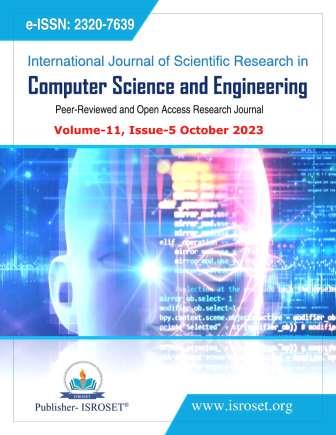Malaria Parasite Detection from RBCs Images Using Deep Learning Techniques
Keywords:
Disease Detection, Malaria, CNN, Deep Learning Techniques, MobileNet, Xception, InceptionV3Abstract
Malaria is one the life-threaten diseases spread in many countries worldwide with high infection rates in tropical and subtropical countries. According to WHO half of the world`s population is at risk of malaria, and nearly every minute malaria kills a child in the world. Fortunately, this disease is preventable and treatable but accurate and fast diagnosis is a crucial stage of malaria treatment. Many methods have been used in malaria detection ranging from traditional that are based on human experts and microscopes to machine-based methods that depend on machine learning and deep learning. This paper proposes a deep-learning method for malaria detection from RBCs images. Obviously, three transfer learning models (MobileNet, Xception, and InceptionV3) were proposed and compared based on their precision, recall, f1-Score, and accuracy. Hence, by comparing the three models, the MobileNet model is the best in terms of overall accuracy (99.04%), we can confirm that with the results of area under the curve (0.981). Therefore, the pre-trained MobileNet model can effectively contribute to malaria classification from RBCs images.
References
B. Giannone, N. Hedrich, P. Schlagenhauf, “Imported malaria in Switzerland, (1990–2019): A retrospective analysis”, Travel Medicine and Infectious Disease, 45, p.102251, 2022.
J.C. Shaorga, “Malaria Transmission Dynamics Incorporating Asymptomatic Human Compartment”, International Journal of Scientific Research in Mathematical and Statistical Sciences, Vol.9, Issue 3, pp.01-10, 2022.
A.A. Theodosiou, R.C. Read, “Artificial intelligence, machine learning and deep learning: potential resources for the infection clinician”, Journal of Infection, Vol.87, Issue 4, pp.287-294, 2023. https://doi.org/10.1016/j.jinf.2023.07.006
S. Suganyadevi, V. Seethalakshmi, K. Balasamy, “A review on deep learning in medical image analysis”. International Journal of Multimedia Information Retrieval, Vol.11, Issue 1, pp.19-38, 2022. https://doi.org/10.1007/s13735-021-00218-1
A.A. Rawi, M.K. Elbashir, A.M. Ahmed, “Classification of 27 heart abnormalities using 12-lead ECG signals with combined deep learning techniques”, Bulletin of Electrical Engineering and Informatics, Vol.12, Issue 4, pp. 2220-2235, 2023. https://doi.org/10.11591/eei.v12i4.4668
A.A. Rawi, M.K. Elbashir, A.M. Ahmed, “ECG heartbeat classification using CONVXGB model”, Electronics, Vol.11, Issue 15, pp. 2280, 2022. https://doi.org/10.3390/electronics11152280
S.P. Akinrinwa, O. Olabode, O.C. Agbonifo, K.G. Akintola, “Breast Histopathology Images Multi-Classification using Ensemble of Deep Convolutional Neural Networks”, International Journal of Scientific Research in Computer Science and Engineering, Vol.10, Issue 6, pp.09-21, 2022. https://doi.org/10.26438/ijsrcse/v10i6.921
I. Goodfellow, Y. Bengio, A. Courville, “Deep learning”, MIT press, 2016.
S.J. Pan, Q. Yang, “A survey on transfer learning”, IEEE Transactions on knowledge and data engineering, Vol.22, Issue 10, pp.1345-1359, 2009.
D. Sinha, M. El-Sharkawy, “Thin mobilenet: An enhanced mobilenet architecture”, In 2019 IEEE 10th annual ubiquitous computing, electronics & mobile communication conference (UEMCON), New York, USA, (pp. 0280-0285). IEEE, 2019.
A.G. Howard, M. Zhu, B. Chen, D. Kalenichenko, W. Wang, T. Weyand, M. Andreetto, H. Adam, “Mobilenets: Efficient convolutional neural networks for mobile vision applications”, arXiv preprint arXiv:1704.04861, 2017.
F. Chollet, “Xception: Deep learning with depthwise separable convolutions”, In Proceedings of the IEEE conference on computer vision and pattern recognition (pp. 1251-1258), 2017.
C. Szegedy, S. Ioffe, V Vanhoucke, A. Alemi, “Inception-v4, inception-resnet and the impact of residual connections on learning”, In Proceedings of the AAAI conference on artificial intelligence, Vol.31, Issue 1, 2017. https://doi.org/10.1609/aaai.v31i1.11231
A. Géron, “Hands-on machine learning with Scikit-Learn, Keras, and TensorFlow ", O'Reilly Media, Inc., 2022.
C. Szegedy, V. Vanhoucke, S. Ioffe, J. Shlens, Z. Wojna, “Rethinking the inception architecture for computer vision”, In Proceedings of the IEEE conference on computer vision and pattern recognition (pp. 2818-2826), 2016.
C.B. Jones, C. Murugamani,” Malaria parasite detection on microscopic blood smear images with integrated deep learning algorithms”, Int. Arab J. Inf. Technol., Vol.20, Issue 2, pp.170-179, 2023.
A. Alaiad, A. Migdady, R.E.M. Al-Khatib, O. Alzoubi, R.A. Zitar, L. Abualigah, ”Autokeras Approach: A Robust Automated Deep Learning Network for Diagnosis Disease Cases in Medical Images”, Journal of Imaging, Vol.9, Issue 3, p.64, 2023. https://doi.org/10.3390/jimaging9030064
G. Shekar, S. Revathy, E.K. Goud, “Malaria detection using deep learning”, In 2020 4th international conference on trends in electronics and informatics (ICOEI)(48184),Tirunelveli, India, (pp. 746-750), IEEE, 2020.
K. Hemachandran, A. Alasiry, M. Marzougui, S.M. Ganie, A.A. Pise, M.T.H. Alouane, C. Chola, “Performance analysis of deep learning algorithms in diagnosis of malaria disease”, Diagnostics, Vol.13, Issue 3, p.534, 2023. https://doi.org/10.3390/diagnostics13030534
T. Jameela, K. Athota, N. Singh, V.K. Gunjan, S. Kahali, “Deep learning and transfer learning for malaria detection” , Computational Intelligence and Neuroscience, Vol.2022, 2022. https://doi.org/10.1155/2022/2221728
M.S. Rahman, N. Rifat, M. Ahsan, S Islam., M. Chowdhury, R. Gome, “Deep Learning Application for Detection of Malaria”, In 2023 IEEE International Conference on Electro Information Technology (eIT), Romeoville, IL, USA, (pp. 1-5). IEEE, 2023.
T.K. Kundu, D.K. Anguraj, “Optimal Machine Learning Based Automated Malaria Parasite Detection and Classification Model Using Blood Smear Images”. Traitement du Signal, Vol.40, Issue 1, p.91-99, 2023.
I. Jdey, G. Hcini, H. Ltifi, “Deep learning and machine learning for Malaria detection: overview, challenges and future directions”, arXiv preprint arXiv:2209.13292, 2022.
M.H.D. Alnussairi, A.A. İbrahim, “Malaria parasite detection using deep learning algorithms based on (CNNs) technique”. Computers and Electrical Engineering, Vol.103, p. 108316, 2022. https://doi.org/10.1016/j.compeleceng.2022.108316
Y.W. Lee, J.W. Choi, E.H. Shin, “Machine learning model for predicting malaria using clinical information”, Computers in Biology and Medicine, Vol.129, p.104151, 2021. https://doi.org/10.1016/j.compbiomed.2020.104151
S. D. Raut, S. A. Thorat, “Deep Learning Techniques: A Review”, International Journal of Scientific Research in Computer Science and Engineering, Vol.8, Issue 1, pp.105-109, 2020.
Downloads
Published
How to Cite
Issue
Section
License

This work is licensed under a Creative Commons Attribution 4.0 International License.
Authors contributing to this journal agree to publish their articles under the Creative Commons Attribution 4.0 International License, allowing third parties to share their work (copy, distribute, transmit) and to adapt it, under the condition that the authors are given credit and that in the event of reuse or distribution, the terms of this license are made clear.







